Reflective Essay on the Impact of Organizational Behaviour Learning
VerifiedAdded on 2023/06/03
|6
|1531
|358
Essay
AI Summary
This reflective essay explores the impact of organizational behaviour (OB) learning on an individual's thinking, behaviour, and approaches, both personally and as a team member. Drawing from personal experiences as an Operations Executive, the essay discusses the importance of organizational behaviour in contributing to individual development within and outside the workplace. It emphasizes the role of leadership, emotional intelligence, and cultural sensitivity in a diverse organizational setting. The essay also touches upon the shift towards flexible work environments and the importance of ethical standards and emotional awareness in management. Ultimately, it concludes that understanding organizational behaviour is crucial for regulating emotions and aligning behaviour with the organizational culture, leading to improved performance and employee well-being. Desklib provides access to similar essays and study tools for students.
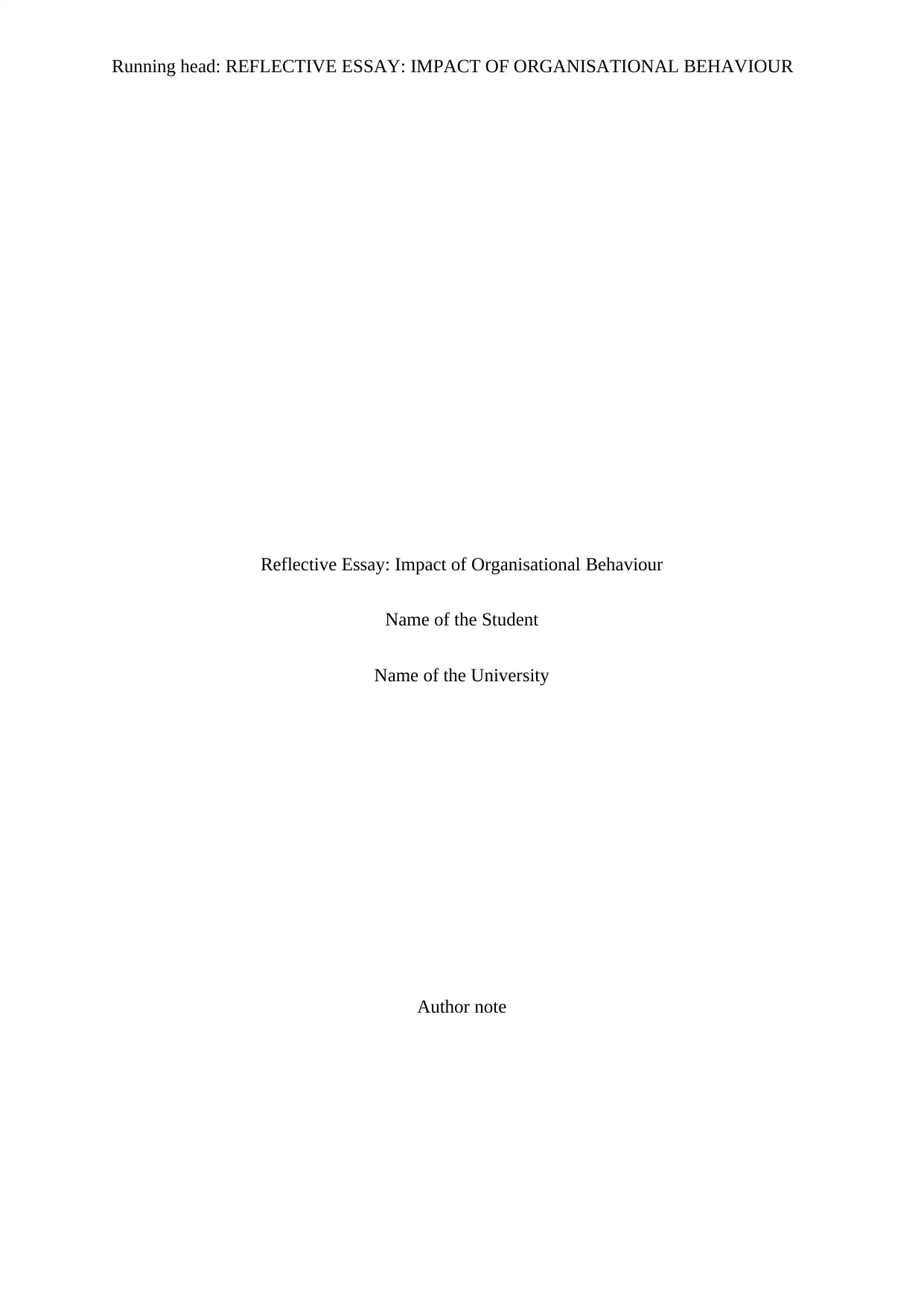
Running head: REFLECTIVE ESSAY: IMPACT OF ORGANISATIONAL BEHAVIOUR
Reflective Essay: Impact of Organisational Behaviour
Name of the Student
Name of the University
Author note
Reflective Essay: Impact of Organisational Behaviour
Name of the Student
Name of the University
Author note
Paraphrase This Document
Need a fresh take? Get an instant paraphrase of this document with our AI Paraphraser
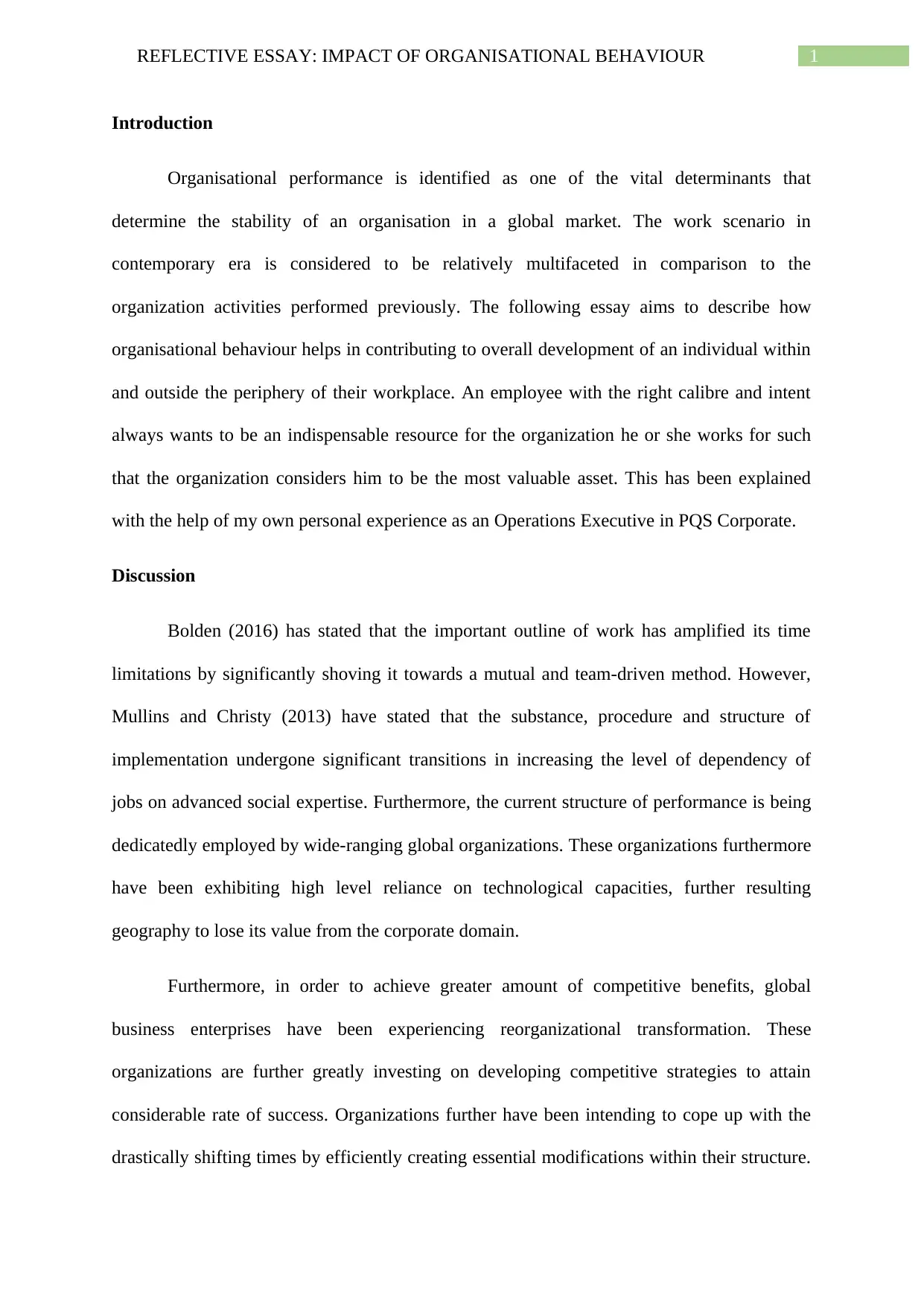
1REFLECTIVE ESSAY: IMPACT OF ORGANISATIONAL BEHAVIOUR
Introduction
Organisational performance is identified as one of the vital determinants that
determine the stability of an organisation in a global market. The work scenario in
contemporary era is considered to be relatively multifaceted in comparison to the
organization activities performed previously. The following essay aims to describe how
organisational behaviour helps in contributing to overall development of an individual within
and outside the periphery of their workplace. An employee with the right calibre and intent
always wants to be an indispensable resource for the organization he or she works for such
that the organization considers him to be the most valuable asset. This has been explained
with the help of my own personal experience as an Operations Executive in PQS Corporate.
Discussion
Bolden (2016) has stated that the important outline of work has amplified its time
limitations by significantly shoving it towards a mutual and team-driven method. However,
Mullins and Christy (2013) have stated that the substance, procedure and structure of
implementation undergone significant transitions in increasing the level of dependency of
jobs on advanced social expertise. Furthermore, the current structure of performance is being
dedicatedly employed by wide-ranging global organizations. These organizations furthermore
have been exhibiting high level reliance on technological capacities, further resulting
geography to lose its value from the corporate domain.
Furthermore, in order to achieve greater amount of competitive benefits, global
business enterprises have been experiencing reorganizational transformation. These
organizations are further greatly investing on developing competitive strategies to attain
considerable rate of success. Organizations further have been intending to cope up with the
drastically shifting times by efficiently creating essential modifications within their structure.
Introduction
Organisational performance is identified as one of the vital determinants that
determine the stability of an organisation in a global market. The work scenario in
contemporary era is considered to be relatively multifaceted in comparison to the
organization activities performed previously. The following essay aims to describe how
organisational behaviour helps in contributing to overall development of an individual within
and outside the periphery of their workplace. An employee with the right calibre and intent
always wants to be an indispensable resource for the organization he or she works for such
that the organization considers him to be the most valuable asset. This has been explained
with the help of my own personal experience as an Operations Executive in PQS Corporate.
Discussion
Bolden (2016) has stated that the important outline of work has amplified its time
limitations by significantly shoving it towards a mutual and team-driven method. However,
Mullins and Christy (2013) have stated that the substance, procedure and structure of
implementation undergone significant transitions in increasing the level of dependency of
jobs on advanced social expertise. Furthermore, the current structure of performance is being
dedicatedly employed by wide-ranging global organizations. These organizations furthermore
have been exhibiting high level reliance on technological capacities, further resulting
geography to lose its value from the corporate domain.
Furthermore, in order to achieve greater amount of competitive benefits, global
business enterprises have been experiencing reorganizational transformation. These
organizations are further greatly investing on developing competitive strategies to attain
considerable rate of success. Organizations further have been intending to cope up with the
drastically shifting times by efficiently creating essential modifications within their structure.
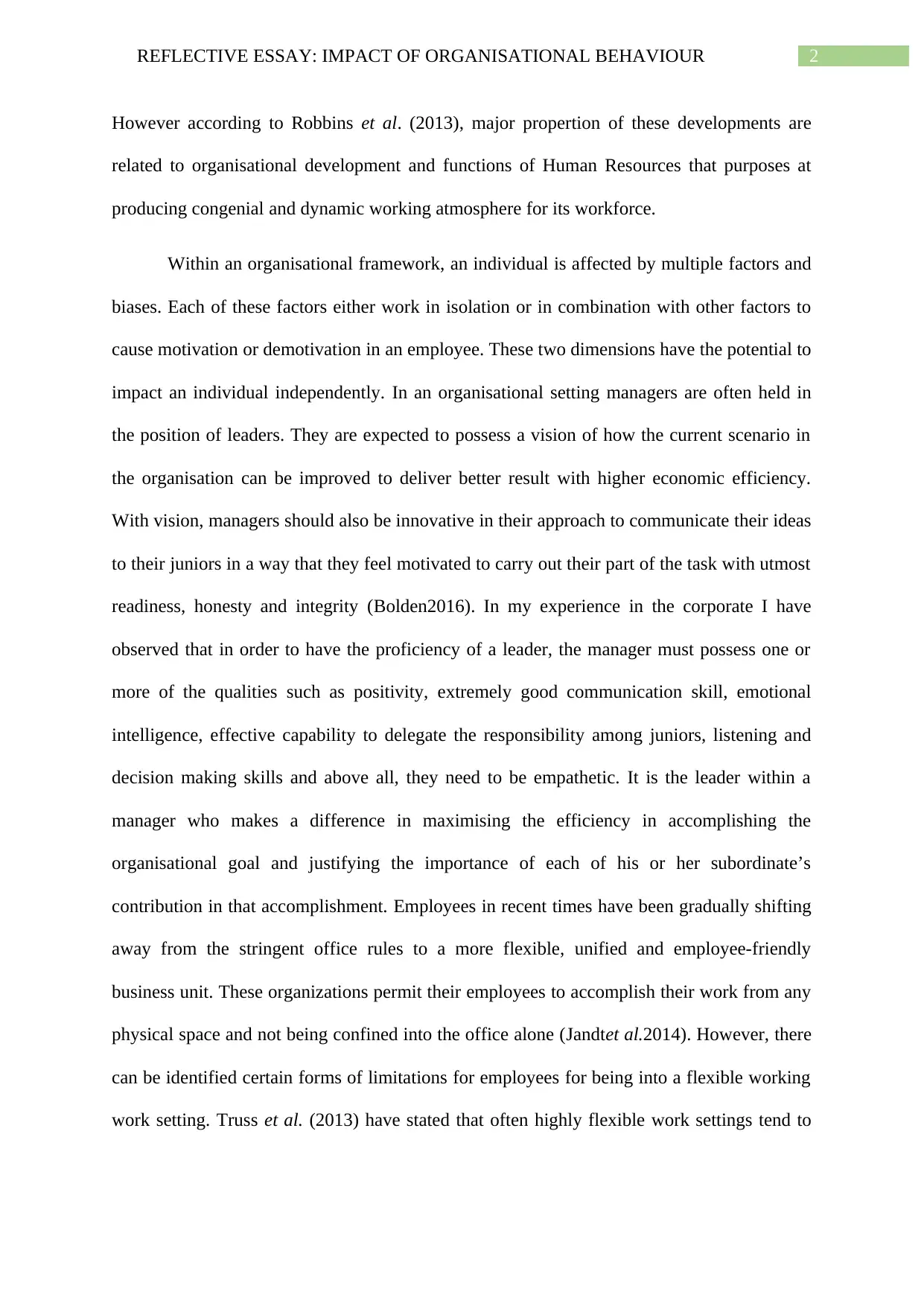
2REFLECTIVE ESSAY: IMPACT OF ORGANISATIONAL BEHAVIOUR
However according to Robbins et al. (2013), major propertion of these developments are
related to organisational development and functions of Human Resources that purposes at
producing congenial and dynamic working atmosphere for its workforce.
Within an organisational framework, an individual is affected by multiple factors and
biases. Each of these factors either work in isolation or in combination with other factors to
cause motivation or demotivation in an employee. These two dimensions have the potential to
impact an individual independently. In an organisational setting managers are often held in
the position of leaders. They are expected to possess a vision of how the current scenario in
the organisation can be improved to deliver better result with higher economic efficiency.
With vision, managers should also be innovative in their approach to communicate their ideas
to their juniors in a way that they feel motivated to carry out their part of the task with utmost
readiness, honesty and integrity (Bolden2016). In my experience in the corporate I have
observed that in order to have the proficiency of a leader, the manager must possess one or
more of the qualities such as positivity, extremely good communication skill, emotional
intelligence, effective capability to delegate the responsibility among juniors, listening and
decision making skills and above all, they need to be empathetic. It is the leader within a
manager who makes a difference in maximising the efficiency in accomplishing the
organisational goal and justifying the importance of each of his or her subordinate’s
contribution in that accomplishment. Employees in recent times have been gradually shifting
away from the stringent office rules to a more flexible, unified and employee-friendly
business unit. These organizations permit their employees to accomplish their work from any
physical space and not being confined into the office alone (Jandtet al.2014). However, there
can be identified certain forms of limitations for employees for being into a flexible working
work setting. Truss et al. (2013) have stated that often highly flexible work settings tend to
However according to Robbins et al. (2013), major propertion of these developments are
related to organisational development and functions of Human Resources that purposes at
producing congenial and dynamic working atmosphere for its workforce.
Within an organisational framework, an individual is affected by multiple factors and
biases. Each of these factors either work in isolation or in combination with other factors to
cause motivation or demotivation in an employee. These two dimensions have the potential to
impact an individual independently. In an organisational setting managers are often held in
the position of leaders. They are expected to possess a vision of how the current scenario in
the organisation can be improved to deliver better result with higher economic efficiency.
With vision, managers should also be innovative in their approach to communicate their ideas
to their juniors in a way that they feel motivated to carry out their part of the task with utmost
readiness, honesty and integrity (Bolden2016). In my experience in the corporate I have
observed that in order to have the proficiency of a leader, the manager must possess one or
more of the qualities such as positivity, extremely good communication skill, emotional
intelligence, effective capability to delegate the responsibility among juniors, listening and
decision making skills and above all, they need to be empathetic. It is the leader within a
manager who makes a difference in maximising the efficiency in accomplishing the
organisational goal and justifying the importance of each of his or her subordinate’s
contribution in that accomplishment. Employees in recent times have been gradually shifting
away from the stringent office rules to a more flexible, unified and employee-friendly
business unit. These organizations permit their employees to accomplish their work from any
physical space and not being confined into the office alone (Jandtet al.2014). However, there
can be identified certain forms of limitations for employees for being into a flexible working
work setting. Truss et al. (2013) have stated that often highly flexible work settings tend to
⊘ This is a preview!⊘
Do you want full access?
Subscribe today to unlock all pages.

Trusted by 1+ million students worldwide
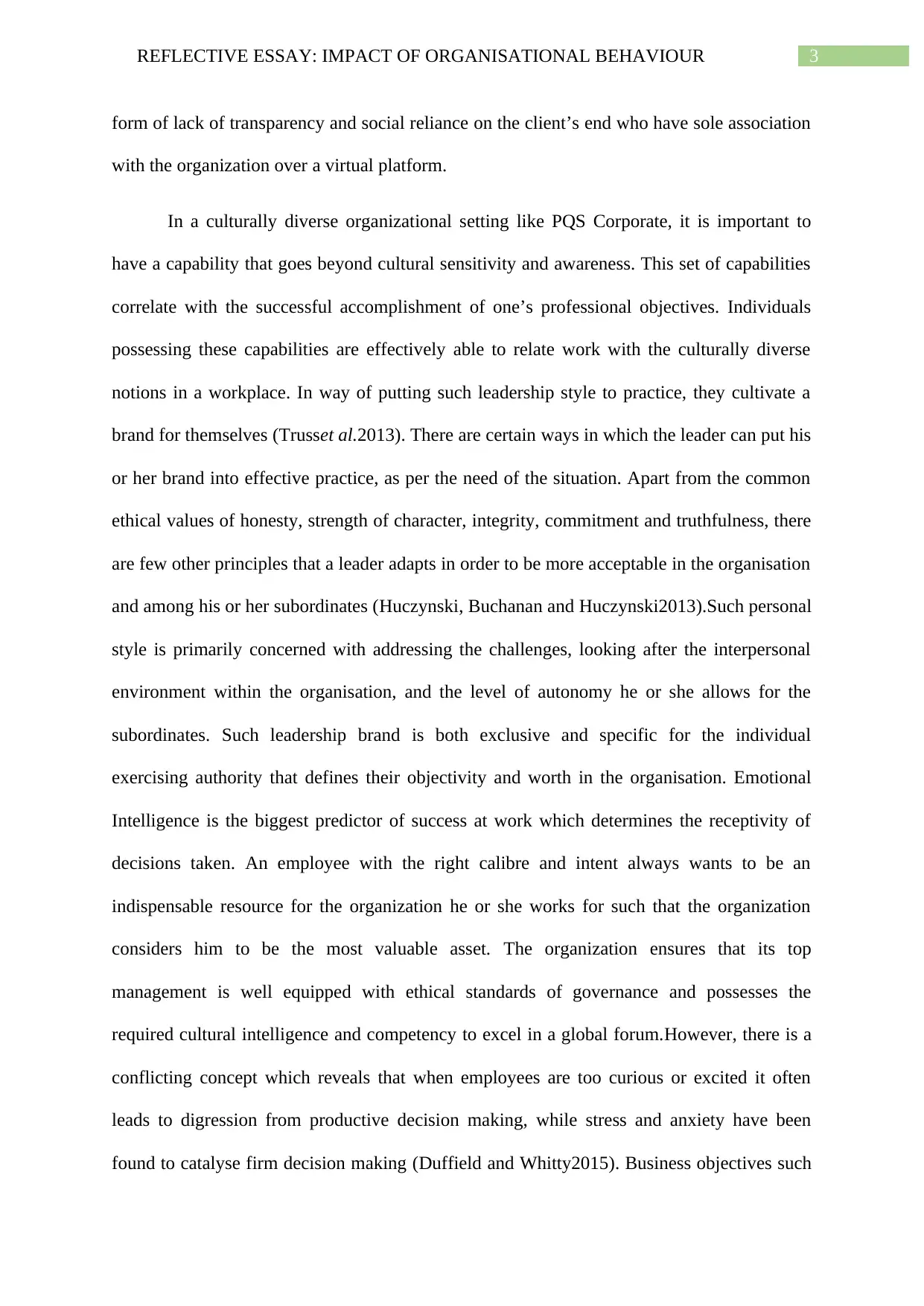
3REFLECTIVE ESSAY: IMPACT OF ORGANISATIONAL BEHAVIOUR
form of lack of transparency and social reliance on the client’s end who have sole association
with the organization over a virtual platform.
In a culturally diverse organizational setting like PQS Corporate, it is important to
have a capability that goes beyond cultural sensitivity and awareness. This set of capabilities
correlate with the successful accomplishment of one’s professional objectives. Individuals
possessing these capabilities are effectively able to relate work with the culturally diverse
notions in a workplace. In way of putting such leadership style to practice, they cultivate a
brand for themselves (Trusset al.2013). There are certain ways in which the leader can put his
or her brand into effective practice, as per the need of the situation. Apart from the common
ethical values of honesty, strength of character, integrity, commitment and truthfulness, there
are few other principles that a leader adapts in order to be more acceptable in the organisation
and among his or her subordinates (Huczynski, Buchanan and Huczynski2013).Such personal
style is primarily concerned with addressing the challenges, looking after the interpersonal
environment within the organisation, and the level of autonomy he or she allows for the
subordinates. Such leadership brand is both exclusive and specific for the individual
exercising authority that defines their objectivity and worth in the organisation. Emotional
Intelligence is the biggest predictor of success at work which determines the receptivity of
decisions taken. An employee with the right calibre and intent always wants to be an
indispensable resource for the organization he or she works for such that the organization
considers him to be the most valuable asset. The organization ensures that its top
management is well equipped with ethical standards of governance and possesses the
required cultural intelligence and competency to excel in a global forum.However, there is a
conflicting concept which reveals that when employees are too curious or excited it often
leads to digression from productive decision making, while stress and anxiety have been
found to catalyse firm decision making (Duffield and Whitty2015). Business objectives such
form of lack of transparency and social reliance on the client’s end who have sole association
with the organization over a virtual platform.
In a culturally diverse organizational setting like PQS Corporate, it is important to
have a capability that goes beyond cultural sensitivity and awareness. This set of capabilities
correlate with the successful accomplishment of one’s professional objectives. Individuals
possessing these capabilities are effectively able to relate work with the culturally diverse
notions in a workplace. In way of putting such leadership style to practice, they cultivate a
brand for themselves (Trusset al.2013). There are certain ways in which the leader can put his
or her brand into effective practice, as per the need of the situation. Apart from the common
ethical values of honesty, strength of character, integrity, commitment and truthfulness, there
are few other principles that a leader adapts in order to be more acceptable in the organisation
and among his or her subordinates (Huczynski, Buchanan and Huczynski2013).Such personal
style is primarily concerned with addressing the challenges, looking after the interpersonal
environment within the organisation, and the level of autonomy he or she allows for the
subordinates. Such leadership brand is both exclusive and specific for the individual
exercising authority that defines their objectivity and worth in the organisation. Emotional
Intelligence is the biggest predictor of success at work which determines the receptivity of
decisions taken. An employee with the right calibre and intent always wants to be an
indispensable resource for the organization he or she works for such that the organization
considers him to be the most valuable asset. The organization ensures that its top
management is well equipped with ethical standards of governance and possesses the
required cultural intelligence and competency to excel in a global forum.However, there is a
conflicting concept which reveals that when employees are too curious or excited it often
leads to digression from productive decision making, while stress and anxiety have been
found to catalyse firm decision making (Duffield and Whitty2015). Business objectives such
Paraphrase This Document
Need a fresh take? Get an instant paraphrase of this document with our AI Paraphraser
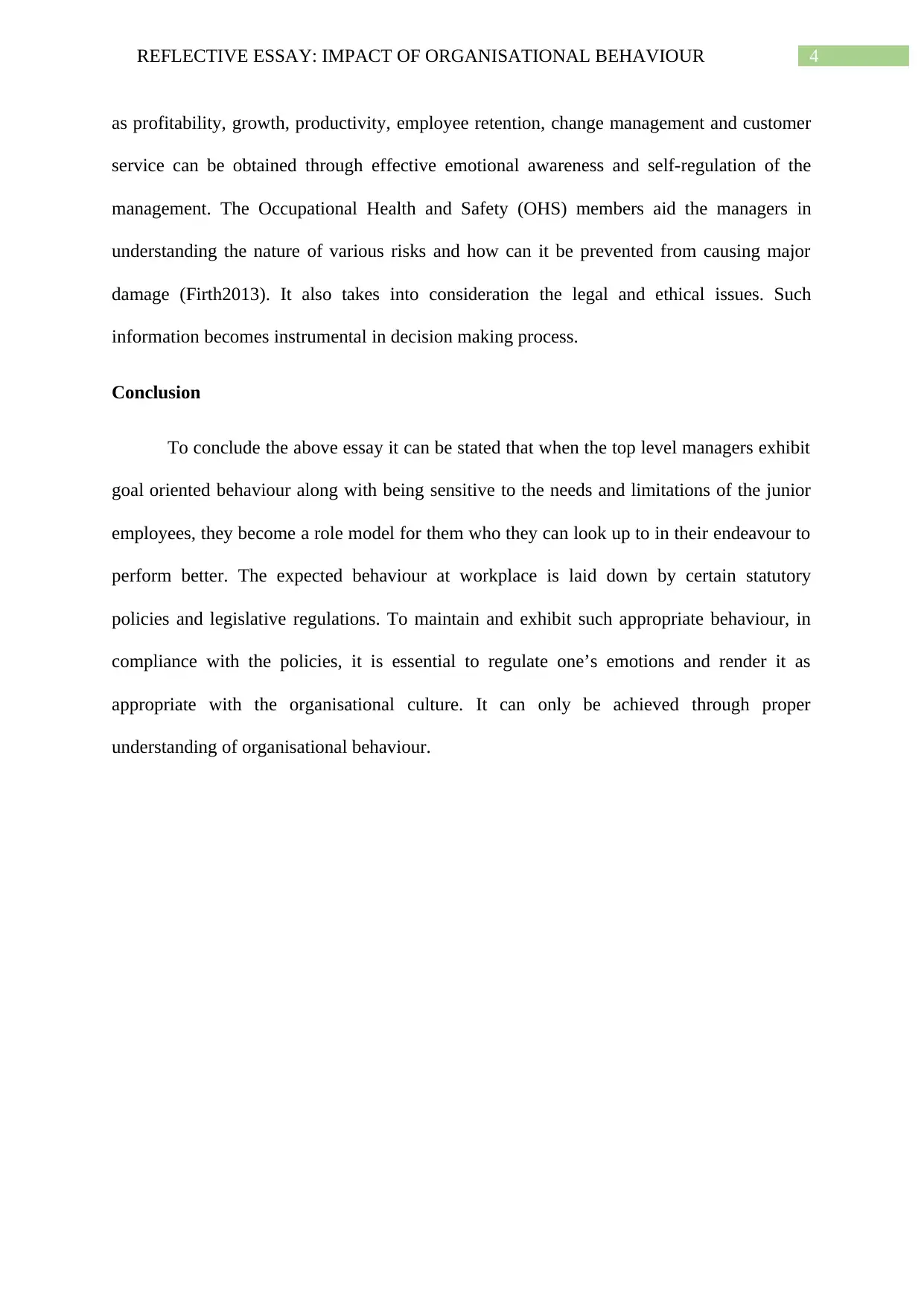
4REFLECTIVE ESSAY: IMPACT OF ORGANISATIONAL BEHAVIOUR
as profitability, growth, productivity, employee retention, change management and customer
service can be obtained through effective emotional awareness and self-regulation of the
management. The Occupational Health and Safety (OHS) members aid the managers in
understanding the nature of various risks and how can it be prevented from causing major
damage (Firth2013). It also takes into consideration the legal and ethical issues. Such
information becomes instrumental in decision making process.
Conclusion
To conclude the above essay it can be stated that when the top level managers exhibit
goal oriented behaviour along with being sensitive to the needs and limitations of the junior
employees, they become a role model for them who they can look up to in their endeavour to
perform better. The expected behaviour at workplace is laid down by certain statutory
policies and legislative regulations. To maintain and exhibit such appropriate behaviour, in
compliance with the policies, it is essential to regulate one’s emotions and render it as
appropriate with the organisational culture. It can only be achieved through proper
understanding of organisational behaviour.
as profitability, growth, productivity, employee retention, change management and customer
service can be obtained through effective emotional awareness and self-regulation of the
management. The Occupational Health and Safety (OHS) members aid the managers in
understanding the nature of various risks and how can it be prevented from causing major
damage (Firth2013). It also takes into consideration the legal and ethical issues. Such
information becomes instrumental in decision making process.
Conclusion
To conclude the above essay it can be stated that when the top level managers exhibit
goal oriented behaviour along with being sensitive to the needs and limitations of the junior
employees, they become a role model for them who they can look up to in their endeavour to
perform better. The expected behaviour at workplace is laid down by certain statutory
policies and legislative regulations. To maintain and exhibit such appropriate behaviour, in
compliance with the policies, it is essential to regulate one’s emotions and render it as
appropriate with the organisational culture. It can only be achieved through proper
understanding of organisational behaviour.
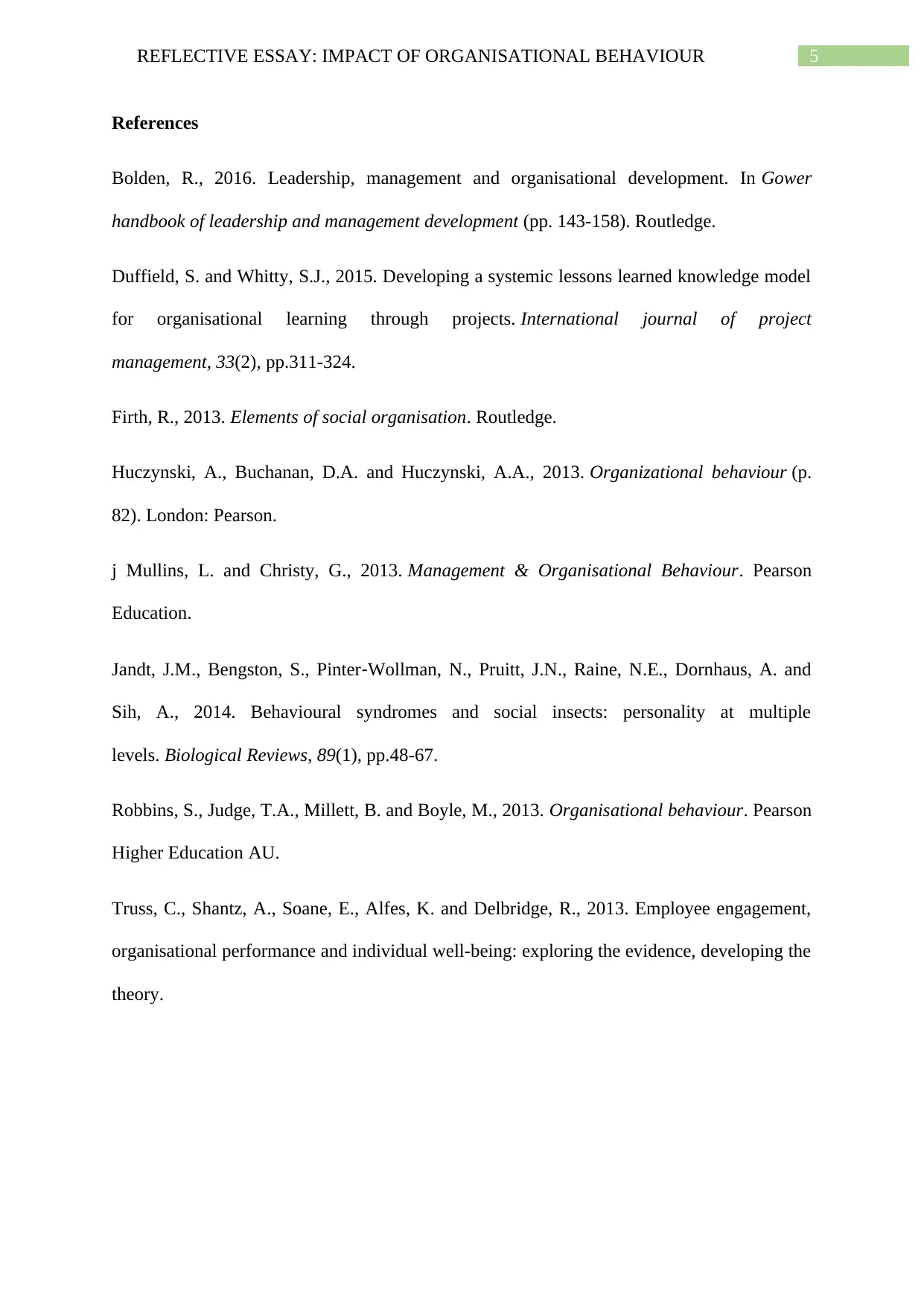
5REFLECTIVE ESSAY: IMPACT OF ORGANISATIONAL BEHAVIOUR
References
Bolden, R., 2016. Leadership, management and organisational development. In Gower
handbook of leadership and management development (pp. 143-158). Routledge.
Duffield, S. and Whitty, S.J., 2015. Developing a systemic lessons learned knowledge model
for organisational learning through projects. International journal of project
management, 33(2), pp.311-324.
Firth, R., 2013. Elements of social organisation. Routledge.
Huczynski, A., Buchanan, D.A. and Huczynski, A.A., 2013. Organizational behaviour (p.
82). London: Pearson.
j Mullins, L. and Christy, G., 2013. Management & Organisational Behaviour. Pearson
Education.
Jandt, J.M., Bengston, S., Pinter‐Wollman, N., Pruitt, J.N., Raine, N.E., Dornhaus, A. and
Sih, A., 2014. Behavioural syndromes and social insects: personality at multiple
levels. Biological Reviews, 89(1), pp.48-67.
Robbins, S., Judge, T.A., Millett, B. and Boyle, M., 2013. Organisational behaviour. Pearson
Higher Education AU.
Truss, C., Shantz, A., Soane, E., Alfes, K. and Delbridge, R., 2013. Employee engagement,
organisational performance and individual well-being: exploring the evidence, developing the
theory.
References
Bolden, R., 2016. Leadership, management and organisational development. In Gower
handbook of leadership and management development (pp. 143-158). Routledge.
Duffield, S. and Whitty, S.J., 2015. Developing a systemic lessons learned knowledge model
for organisational learning through projects. International journal of project
management, 33(2), pp.311-324.
Firth, R., 2013. Elements of social organisation. Routledge.
Huczynski, A., Buchanan, D.A. and Huczynski, A.A., 2013. Organizational behaviour (p.
82). London: Pearson.
j Mullins, L. and Christy, G., 2013. Management & Organisational Behaviour. Pearson
Education.
Jandt, J.M., Bengston, S., Pinter‐Wollman, N., Pruitt, J.N., Raine, N.E., Dornhaus, A. and
Sih, A., 2014. Behavioural syndromes and social insects: personality at multiple
levels. Biological Reviews, 89(1), pp.48-67.
Robbins, S., Judge, T.A., Millett, B. and Boyle, M., 2013. Organisational behaviour. Pearson
Higher Education AU.
Truss, C., Shantz, A., Soane, E., Alfes, K. and Delbridge, R., 2013. Employee engagement,
organisational performance and individual well-being: exploring the evidence, developing the
theory.
⊘ This is a preview!⊘
Do you want full access?
Subscribe today to unlock all pages.

Trusted by 1+ million students worldwide
1 out of 6
Related Documents
Your All-in-One AI-Powered Toolkit for Academic Success.
+13062052269
info@desklib.com
Available 24*7 on WhatsApp / Email
![[object Object]](/_next/static/media/star-bottom.7253800d.svg)
Unlock your academic potential
Copyright © 2020–2025 A2Z Services. All Rights Reserved. Developed and managed by ZUCOL.





